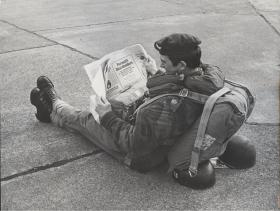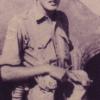Exercise MacDrop was a 15 PARA (SV) Exercise which began in July/August 1969 and continued as a biannual exercise thereafter. It took place out of RAF Machrihanish, where the Hawker-Siddeley CMk1 Andovers of No. 46 Squadron RAF needed paratroopers for their deployment exercises. These exercises kept 46 Squadron's aircrew in-date, whilst offering regular and TA paratroopers the opportunity to jump from a new aircraft. It was therefore a highly advantageous exercise for all parties.
The account below has been kindly supplied to us by Pat Conn, who was 15 PARA's adjutant when the exercise was first held:
This exercise was an RAF parachuting exercise linked to a deployment, but it needed troops. These were provided by 15 PARA and sometimes bolstered by D Sqn 23 SAS (R) at Invergowrie near Dundee. Its genesis was a result of the CO of 15 PARA [Joe Starling] calling in on old mates at RAF Abingdon in 1969 and agreeing to `help out’ where he can.
As the Adjutant 15 PARA, I was also covering for some of the work of the Training Major who was busy organising an Army Expedition to Tirich Mir in the Himalayas. The first indication I got of MacDrop was a `JoeGram’, a scribbled Memo on bilious green paper written in the staff car or train. It gave a contact number at RAF Abingdon and an order to fix the exercise…and at short notice.
Exercise MacDrop
46 Sqn RAF were based at RAF Abingdon which also was the home for No 1 Parachute Training School at that time.. The Squadron had been re-roled as a transport support and tactical squadron equipped with the Hawker Siddeley CMk1 Andover.
It was used widely at this time as a VIP aircraft, light transport aircraft, aero-medevac and air supply of both stores and men. Like all aircrew however, they had to keep in date and their twice yearly deployment exercises were designed to do this. The deployment was to RAF Machrihanish at the tip of the Kintyre Peninsula in Argyle and Bute and close to Campbeltown. It was into this setting that Joe arrived to see his mate who just happened to be commanding the Andover Sqn and who’s telephone number I had been given.
It quickly became apparent after a telephone chat that he needed to operate out of various Scottish airfields and drop by both day and night at various DZs. The aircraft also would need to airland `stores’ in the form of vehicles to use the Andover ‘kneel’ facility (lowering the tail ramp) and also to drop SEAC supply packs by parachute. I needed to fix troops, parachutes, DZ parties, DZ medical cover, and recovery of stores. They would do all of the air staff work associated with the exercise. After some initial discussion with the CO I decided that I would need helicopter support if I was to move DZ parties around and move SEAC packs to the next airport for recovery to the Squadron. I was assured that the Sqn had the services of a detachment of 47 Air Dispatch Sqn RCT.
The numbers of paratroopers for required for jumping was not great, but the admin took some coordination. The CO told me to use Permanent Staff where I could for this first exercise, they were cheaper to `repair’ if I bend them than TA soldiers. Needless to say though, the TA soldiers were the keenest to jump and I always had enough volunteers. I had the use of two Whirlwind HAR 9, one RAF the other RN. I had asked for Wessex, but was gently told to push-off.
The mounting airfields used on this first iteration of the exercise was airframes would leave Machrihanish and fly to Abbotsinch (Glasgow), Dyce (Aberdeen) or Turnhouse (Edinburgh), and I think that I used Prestwick on one occasion. The aircraft would fly to the appropriate DZ drop its small stick of paratroopers, then a stores run. In the meantime, the DZ party collected used parachutes and backloaded by road, stores loads (usually SEAC packs and parachutes) were loaded on to a helicopter and flown to one of the airfields where they would be picked up by a Machrihanish team. The DZ party would then be relocated to another DZ if necessary by air. If I recall we used Barry Budden near Dundee, Lady Auckland near to Stirling and sometimes Bannockburn if it was a troops only drop. The first exercise was crazy, but then it was refined for later years, but I had left by then. It continued in various forms for several years. It was a typical win-win situation. The Andover crews needed qualification updates, and paratroopers were happy to oblige. It was not unknown for the CO to crack in two jumps a day. He would be met on the DZ by the staff car and roar off to the next pick-up airfield.
Finally the tale of MacDrop in Joe Starling’s book happened the next year after this initial exercise described here, and I am assured that it was true. I seem to recall Jock Fox was the RAF DZ safety officer involved and David Herberts was the Training Major by that time…with Joe still running wild in Scotland… and yes I am guilty as the `officer responsible’ for the 15 PARA Fan Exit trainer tale. Joe thought it was a brilliant wheeze and our Honorary Colonel at the time, Brigadier Alastair Pearson thought it was even funnier, he of course having a reputation for being an `unconventional soldier!’
MacDrop III April 1970
MacDrop appears to have been repeated twice in 1970. In late April 1970, as the Pegasus Journal notes,
"Police and ambulances were called out one morning at the end of April by a distressed farmer who had watched the crew baling out of their stricken Andover on the moors behind Greenock. He was right and he was wrong. The Andover was not ailing and it was 15 Para who were bailing out at the end of a week of intensive jumping on DZs all over Scotland with the Andover Squadron on exercise "Mac Drop"...One drop was distinctly short; C/Sgt George Easton smashed his way through a four-foot stone wall with hsi head which was clearly his safest point; down came L/Cpl. Panton with the telephone wires to a local farm and Lt-Col Joe Starling was rapidly updating his water landing drills as he careered down the sky heading for a reservoir (he missed)."
Joe Starling's story is probably from the same April 1970 MacDrop (MacDrop III) and not September as his book suggests. This is because the firemen went on strike in April and the Pegasus Journal tells a similar story from April. It involved Andovers flying from Thorney Island to RAF Machrihanish to drop men at Barry Buddon Training Camp. As Starling recalled, "15 PARA were invited to mobilise their permanent staff, the Glaswegian unemployed and any others available, to provide the parachutists". Unfortunately, some of the RAF personnel were not immediately available and the fire service was on strike. Starling continues, "hurried telephone conversations with the Andover Squadron CO at Machrihanish re-established the exercise, with a pick up at 0030 to drop the first lift at 0100 and the second at 0130 hrs". Later in the evening, Starling could not find the DZ Safety Officer as he was in bed with a barmaid at the Bruce Hotel. The 58 parachutists meanwhile had graciously accepted the offer to take part in the RAF's Battle of Britain commemorations while they waited. Finally, "the drop took place exactly on time but the CO was concerned at the effect of the excitement of the descent and the very chilly night air on the troops, who had imbibed freely of the RAF's kind hospitality, since a DZ casualty or two on a night descent is not unusual. 'You won't believe this', said the Adjutant [presumably Hamish McGregor], having got his RV report, 'they're all here and they're all fit - but they're all p----d! Knowing the value of discretion, 15 PARA went on to minimum stags till first light. The moral would appear to be that night drops don't hurt if you're well oiled".
Mac Drop IV Autumn 1970
The Pegasus journal of October 1970 describes the later MacDrop IV:
"Mac Drop IV gave us the opportunity to work with Andovers and Whirlwinds on DZs all over Scotland and we were able to average one hundred descents a day for six consecutive days. Some of the long, low, level approach flights tended to be bumpy and air sickness sufferers suffered, including one, who shall remain nameless, who realised just before jumping that his false teeth had joined his other contribution to his sick bag. Paradoxically his misfortune made us all feel better and the story, oft repeated, has passed into 15 PARA folklore".
Source:
Compiled with Information from:
Personal account from Lt Col. Walker P Conn
15 PARA 1947-1993 (published 1997), historical booklet written by Alasdair Hutton
Airborne Assault Archive (Box 2.B.4 26.15.1)
Pegasus Journals of July and October 1970
Editing by Alex Walker
Read More






Latest Comments
There are currently no comments for this content.
Add Comment
In order to add comments you must be registered with ParaData.
If you are currently a ParaData member please login.
If you are not currently a ParaData member but wish to get involved please register.